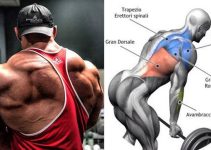The fact that you have a “back” day in the gym, does not automatically mean that you’ll build a great back. You could be making many mistakes without even knowing it. Here are the most common back workout mistakes that guys make in the gym.
And you should probably read them before calling yourself a legitimate bodybuilder.
1.You see your back as a single muscle
Your back is actually a group of muscles that work together allowing you to do pulling movements, although the Latissimus dorsi (the wide back muscles) do most of the work.
While training your back, you should also aim for the upper and lower trapezius, the rhomboids, rear delts, teres major and minor muscles and the erector spinae (spinal erectors).
Although many of these muscles are working synchronously in each exercise, you can always shift the focus to a specific area, such as upper lats for example. All you need to do is adjust the grip or use the overhand grip instead of the reverse grip.
In this regard, the training of the back is similar to chest training; you should use different angles and different exercises to more carefully target one or another muscle group.
2. You train your lower back at the beginning of your workout
With an abundance of exercises with free weights – especially barbells, where you lift heavy weights – it is critical to follow the natural curve of the spine.
This will save you from rounding the lower back during exercise. Rounding the spine makes you vulnerable to injuries of the disks that can knock out any weightlifter of the saddle.
The lower back muscles protect your spine and keep you straight. When you lift heavy weights, the lower back muscles must be fresh and full of energy.
Their isometric contraction keeps the lower back in a straight position and secures the intervertebral discs. This is why you should try not to overwork your lower back muscles at the beginning of your workout. Leave your ‘good mornings’ and hyperextensions as last exercises in your back workout.
3. You sacrifice range of motion for weight
You should always try to complete the exercise with a full range of motion. This means pulling back as far as possible, as well as stretching the arms fully in front of you on the negative part of the movement.
The problem is that when using too much weight, the range of motion generally decreases at both ends of the motion, particularly during the pulling part (or the positive part of the repetition).
Although you may watch not to restrain the movement while performing bench press, many athletes do so during pulling movements with too much weight.
Pull the elbows as far as possible beyond the plane of the body when doing movements like dumbbell or barbell rows. Consciously bring the blades together when pulling back, and then allow the weight to pull your hands to the point of complete extension.
Of course, you should use a weight that allows you this kind of a controlled movement.
4. You allow your body to move forward/backwards when doing pull downs or pull ups
Minimal cheating is a common practice during almost every exercise. But you should be careful with the cheating while performing back exercises considering the effect it has on your spine.
And the problem goes beyond the spine effect. When moving back or forward, you use momentum, which steals the growth stimulation in the targeted muscle.
Limit the forward or backward movement when performing pull ups, pull downs or barbell rows. Use lower weights if necessary. This way you are protecting your spine, and keeping your lower back muscles fresh for the other back exercises.
5. You don’t use weightlifting straps
Some lifters avoid using weightlifting straps in fear that they will reduce grip strength and weaken the forearm muscles. While this claim holds truth, this is not a reason to stop using straps completely.
What usually happens is, your grip fails before the large back muscles. This is why using straps on your heaviest sets will help you get a couple more reps.
Use the weightlifting straps only on your heaviest sets when your forearms and hands are likely to fail before your back muscles.
6. You lift your head to look yourself in the mirror
This is especially wrong when you do exercises such as barbell and dumbbell rows. Just think about it, when lifting your head up, you are breaking the natural curvature of your spine.
At the same time you hold a heavy barbell in your hands, which causes a great amount of pressure to your spine. At this point, the least you want is your spine to be in an unnatural position, because of the injury potential.
Resist the urge to look yourself in the mirror. Keep your head in line with the torso and stay safe.
7. You train your biceps before your back
It’s a usual practice to train your back and biceps in one workout. But training the biceps at the beginning of the workout is a big mistake. This is because your arms are being worked by every compound movement you do.
Hitting your biceps before your back will drain all the energy from your arms. And then, when you start working your back you will not have the strength to pull big weights, as your arms will be worked out.
Be sure you train your back with same, if not greater intensity than your front. Don’t let your back be a sad illustration of the saying “out of sight, out of mind”.


